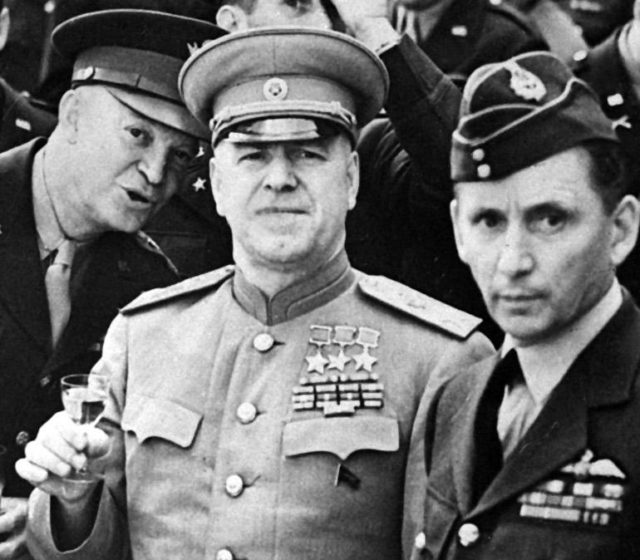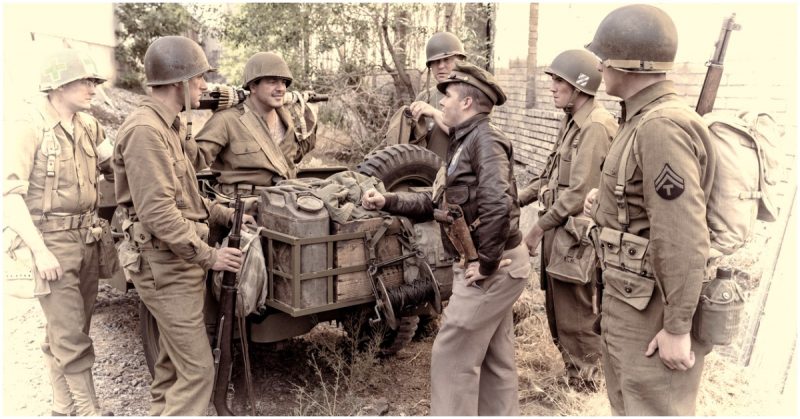1,696 Transport Planes and 1,348 Gliders
They were the aircraft used to transport American and British paratroopers in Operation Varsity on March 24, 1945. Combined with an amphibious assault called Operation Plunder, Varsity was General Montgomery’s operation to fight his way across the Rhine. It involved a massive effort to take a relatively limited but significant patch of ground.
The stiff resistance Montgomery had feared did not emerge. Many Germans recognized the war was lost and preferred to be conquered by the Allies to invasion from Soviet Russia.
41,000 People
The occupants of the concentration camp at Bergen-Belsen when it was liberated on April 15, 1945. It was the first time the horrified British troops saw the inside of the camps. Bergen-Belsen was not an extermination camp, and there were worse horrors still to be unveiled. There the Allies found people starving to death, hundreds so weak that they died in the days following their rescue.
60 Miles
How close the US Ninth Army under General Simpson got to Berlin. They were still advancing on April 15 when General Bradley ordered Simpson to halt. A political decision had been made to focus the American advance elsewhere, effectively leaving the German capital to fall into Soviet hands.
107,405 Tons
The quantity of bombs dropped by Allied air forces in Europe during April 1945, the month before Berlin fell and Germany surrendered.
1,147 Fighter Planes
The number of aircraft remaining to the Luftwaffe to fend off Allied bombers in April 1945. More than half of them were night fighters.
Seven Million Refugees
The estimated number of Germans waiting to be evacuated in the Baltic sector as Russian forces advanced and the Germans fled the feared Red Army.
Two Icebreakers
These specialist ships were set aside for his escape by Erich Koch. He was the Gauleiter in charge of East Prussia and the chief German administrator of the occupied Eastern Territories. He was one of the worst killers in whole Nazi hierarchy. As the people he governed desperately sought ways to flee the advancing Soviets, he redirected resources to ensure his escape along with his personal property and entourage.
2 Russian Armies
Berlin was invaded by not one but two Russian armies. Marshals Ivan Koniev and Georgii Zhukov had both asked for the honor of taking the German capital. Stalin let them both have their way while controlling who would raise the red flag over the Reichstag. The Marshalls competed to show their skill in seizing Berlin.
1,250,000 Soldiers
The forces in Koniev and Zhukov’s armies that took Berlin.
90,000 Boys and Old Men
The Hitler Youth and Home Guard forces called up to defend “Fortress Berlin” as the Russians approached the city. They were ill-equipped and untrained.
20 to 1
How much the Soviets of Army Group Vistula outnumbered the Germans facing them in tanks and planes.
30 Rounds Per Barrel
Most of the artillery used in defending Berlin had little ammunition by the time the Soviets began their attack on the city.
20 Miles of Raised Railway
During the defense of Berlin, commanders used whatever they could find including a 20 mile stretch of elevated railway to provide a defensive barrier in the second zone of the city’s defenses.
6 Tons of Supplies
The total amount received by the beleaguered forces in Berlin when the Luftwaffe tried to resupply them in late April 1945. The meager amount was reported to Hitler on April 29. It was one of the details that convinced him the city would fall, his empire had crumbled, and it was time to end his own life.
Two Hours and Fifteen Minutes
The subject of a grim joke among people remaining in Berlin as the end approached. They said it would take the Russians two hours and fifteen minutes to conquer the city – two hours laughing their heads off at the defenses, then fifteen minutes to destroy them.
9 Days
How long the street fighting for Berlin lasted.
Other German cities had resisted the advancing Allies much longer. By the time Berlin fell, the Germans were exhausted, their strength to fight debilitated, and their material resources spent. Against the aggressive, vengeful and well-supplied Soviets, they stood little chance.
1st Battalion of 756th Regiment
The Russian unit that led the storming of the Reichstag and raised the Red Flag there on April 30. The fighting for the Reichstag was incredibly fierce, even though the defenders must have known they would be defeated. They were SS troops, including French fascists of the Charlemagne Legion.
11 Months
How long Marshal Zhukov got to enjoy his triumph after his troops raised the red flag over the Reichstag and Germany surrendered in May 1945. One year later, Zhukov was demoted by Stalin, who saw him as a threat. He was sent to a series of obscure military command posts.

100,000 Women
The estimated number of rape victims in Berlin during the orgy of looting following its fall. Across the whole of eastern Germany, the number is thought to have been 20 times that amount.
182,000 PoWs
The number of men who surrendered to the Russians on May 9 as part of Army Group Kurland. The force included 43 generals and 8,000 other officers.
Many of them never saw freedom but died in Soviet captivity.
7,856,600 German Combatants
The total number dead, missing or wounded in the German armed forces over the course of the war.
Sources:
Nigel Cawthorne (2004), Turning the Tide: Decisive Battles of the Second World War
John Ellis (1993), The World War II Databook
James Lucas (1986), Last Days of the Reich
